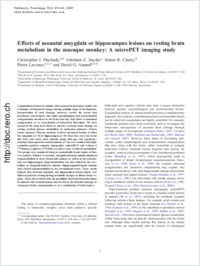Effects of neonatal amygdala or hippocampus lesions on resting brain metabolism in the macaque monkey: A microPET imaging study
- Machado, Christopher J. Department of Psychiatry and Behavioral Sciences, the California National Primate Research Center, UC Davis, Sacramento, USA - The M.I.N.D. Institute, UC Davis, Sacramento, USA
- Snyder, Abraham Z. Department of Radiology, Washington University School of Medicine, St. Louis, USA
- Cherry, Simon R. Department of Biomedical Engineering, Center for Molecular and Genomic Imaging, UC Davis, USA
- Lavenex, Pierre Department of Psychiatry and Behavioral Sciences, the California National Primate Research Center, UC Davis, Sacramento, USA - The M.I.N.D. Institute, UC Davis, Sacramento, USA - Department of Medicine, Unit of Physiology, University of Fribourg, Switzerland
- Amaral, David G. Department of Psychiatry and Behavioral Sciences, the California National Primate Research Center, UC Davis, Sacramento, USA
-
26.09.2007
Published in:
- NeuroImage. - 2008, vol. 39, no. 2, p. 832-846
English
Longitudinal analysis of animals with neonatal brain lesions enables the evaluation of behavioral changes during multiple stages of development. Interpretation of such changes, however, carries the caveat that permanent neural injury also yields morphological and neurochemical reorganization elsewhere in the brain that may lead either to functional compensation or to exacerbation of behavioral alterations. We have measured the long-term effects of selective neonatal brain damage on resting cerebral glucose metabolism in nonhuman primates. Sixteen rhesus monkeys (Macaca mulatta) received neurotoxic lesions of either the amygdala (n = 8) or hippocampus (n = 8) when they were two weeks old. Four years later, these animals, along with age- and experience-matched sham-operated control animals (n = 8), were studied with high-resolution positron emission tomography (microPET) and 2-deoxy-2[¹⁸F]fluoro-d-glucose ([¹⁸F]FDG) to detect areas of altered metabolism. The groups were compared using an anatomically-based region of interest analysis. Relative to controls, amygdala-lesioned animals displayed hypometabolism in three frontal lobe regions, as well as in the neostriatum and hippocampus. Hypermetabolism was also evident in the cerebellum of amygdala-lesioned animals. Hippocampal-lesioned animals only showed hypometabolism in the retrosplenial cortex. These results indicate that neonatal amygdala and hippocampus lesions induce very different patterns of long-lasting metabolic changes in distant brain regions. These observations raise the possibility that behavioral alterations in animals with neonatal lesions may be due to the intended damage, to consequent brain reorganization or to a combination of both factors.
- Faculty
- Faculté des sciences et de médecine
- Department
- Département de Médecine
- Language
-
- English
- Classification
- Biological sciences
- License
- License undefined
- Identifiers
-
- RERO DOC 10563
- DOI 10.1016/j.neuroimage.2007.09.029
- Persistent URL
- https://folia.unifr.ch/unifr/documents/300693
Statistics
Document views: 80
File downloads:
- lavenex_ena.pdf: 148
